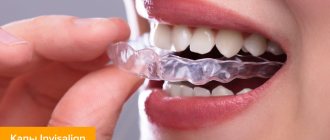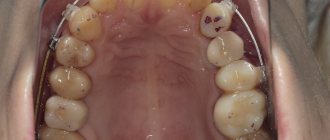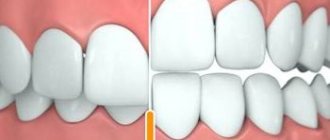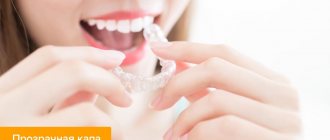Bite defects are not as rare a problem as it might seem. Medical statistics show that every third person has malocclusion in one form or another! If the anomaly is serious and noticeable, it is corrected in adolescence, but people are in no hurry to deal with mild crooked teeth. And most often because they don’t want to wear braces that others can easily see.
But modern dentistry is ready to offer patients an alternative to braces - these are transparent aligners, wearing which can help correct the bite and acquire a beautiful smile. At the same time, your treatment will remain invisible to strangers and will not cause you any discomfort!
In the article we will talk in detail about how bite defects are treated with mouth guards, what are its features, what types of mouth guards exist and how long they will have to be worn in order to straighten the teeth and acquire an attractive smile.
What are orthodontic aligners, indications for use
The aligners also have a second name - aligners. At their core, they are soft and transparent overlays for teeth, which are made from hypoallergenic polymer materials. Mouthguards, unlike braces, are removable structures: you can put them on and take them off yourself, without visiting the orthodontist’s office.
The mechanism of the beneficial action of mouth guards for correcting occlusion is as follows: the design completely covers the jaw arch and creates pressure on the areas of the dentition that need correction. The main advantage of orthodontic aligners is convenience. Wearing them does not cause any discomfort, adaptation to them is quick, and when correcting a bite with mouth guards, there is no need to follow a diet that excludes any food products.
When can mouth guards be used to correct a bite? Indications for the use of orthodontic aligners are as follows:
- The presence of noticeable interdental spaces;
- Slight displacement of individual teeth in a row;
- Slight crowding of teeth;
- Poor open, cross or distal bite.
IMPORTANT: Unfortunately, serious malocclusion cannot be corrected with mouthguards. To correct significant pathologies, braces are used, most often metal ones, which can create strong pressure on the teeth and thereby bring them into the correct position.
Take a short test and calculate the cost of treatment!
Take a short test
- Jaw selection
- Availability of photo
- Selecting a brace system
- Date of treatment
- Cost calculation
×
Manukyan Artavazd Genrikovich
Chief physician of the clinic
Aligners for children
Aligners are most often used to straighten already permanent teeth at an early age. They are absolutely transparent, miniature in size and accurately follow the shape of the teeth.
You can only notice a mouthguard in a person’s mouth from a very close distance. It has minimal effect on articulation (pronunciation of sounds).
Be like a star!
Persuading a child to wear a mouth guard all the time is quite difficult, but it is possible. Children often imitate performers and actors. A worthy argument in favor of aligners is that they were once worn by such stars as Justin Bieber, Khloe Kardashian, Zac Efron, Tom Cruise. They calmly appeared in public, performed, and communicated with people.
How is a bite corrected using mouthguards?
Correcting a bite with mouth guards begins with a visit to the orthodontist's office. During the first appointment, the doctor examines the oral cavity, assesses the correctness of the bite, and additional diagnostic measures may be prescribed - for example, a panoramic photograph of the jaw. A detailed diagnosis before starting orthodontic treatment and bite correction will help the orthodontist choose the most effective correction method for a specific clinical case.
If the diagnosis shows that in your case it is possible to correct the bite with mouthguards, then further treatment will proceed according to the following scheme:
1. Professional oral hygiene will be carried out, necessary for high-quality cleaning of teeth from plaque and tartar.
2. Impressions are taken of the teeth, on the basis of which a plaster model of the patient’s jaws is made.
3. Mouthguards are created using the finished plaster model. Aligners are made not as a single copy, but as a whole set. You will change mouthguards to correct your bite according to the scheme that the orthodontist will develop for you. Changing the aligners is required to create the correct pressure on the teeth, which will promote their displacement and alignment.
IMPORTANT: The effectiveness of correcting your bite with mouthguards will largely depend on your attitude towards treatment. Mouthguards must be worn for at least 20-22 hours. If you break this rule, you may not expect a positive result from bite correction!
Causes
The list of factors that determine the manifestation of functional problems associated with the work of the temporomandibular joint includes:
- Long cycle of exposure to stress;
- Incorrectly performed prosthetics, which caused a violation of occlusion;
- Increased nervous tension, the reaction to which is expressed by clenching the jaws;
- Excessive physical stress on the jaw region;
- Attacks of bruxism - teeth grinding during sleep, caused by neuropathic factors;
- Infectious infections, including the consequences of the development of acute respiratory infections;
- Progression of TMJ pathologies – arthrosis and arthritis;
- Incorrect development of the bite, characterized by occlusal displacement;
- Sustaining mechanical injuries as a result of excessive external force.
The list of specialists involved in the diagnosis of the pathological condition depends on the factors identified during the examination that are believed to have caused the discomfort. Methods used to identify TMJ pathologies include hardware examination using X-rays, CT and MRI, a general blood test and related indicators characterizing the condition of the body.
How many trays may be needed to correct a bite?
How many trays are included in the bite correction kit? The answer to this question will depend on two main factors:
- Difficulties in malocclusion that needs to be corrected;
- Patient's age. The older a person is, the longer orthodontic treatment can be, because after the final formation of the dental system, tooth displacement occurs more slowly. That’s why dentists recommend correcting your bite in childhood and adolescence!
Thus, a full course may require about 15-40 pairs of mouth guards, and each mouth guard will have its own shape and size. To correct the bite, the mouthguards are changed every 2-3 weeks.
Regular change of aligners when correcting a bite is necessary: it allows you to achieve the tightest possible fit of the structure to the teeth. Due to the high density of the mouth guards, they will exert pressure on the teeth, which will cause the teeth to shift in the desired direction. As soon as the pressure becomes insignificant, the used mouth guards are replaced with a new pair.
Installation for children and adults
Braces can be installed on molars at almost any age. The dental system in humans is formed until approximately 17-18 years of age, and the final bite is formed by 12-14 years of age. It is best to get braces during adolescence, as children's dental tissues are more pliable. Staples are also effective in treating adults, but preparation for their installation will require more time and effort. In addition, the healing process will be longer.
Trainers can also be prescribed to both young patients, even those with baby teeth, and older ones. However, it is worth considering that mouth guards are a removable device. If an adult can control himself, then the child will have to be constantly monitored so that he does not remove the aligners if discomfort occurs.
Typically, plates are used when the child’s molars are just erupting, if there is a risk of their improper growth. After the bite is formed, it is better to install braces. As for adults, their choice is determined primarily by indications, and only then by their own preferences.
Types of mouthguards for correcting bite
Orthodontic mouthguards for correcting bites have their own classification. They are divided into different types according to the following characteristics:
— Material of production. Mouthguards for correcting bites can be made of silicone or polyester;
- Production technology. On this basis, standard and individual dental guards are distinguished.
Each type of mouthguard for correcting the bite has its own characteristics, which will be useful for people planning to undergo orthodontic treatment.
Customized dental guards
This is the best option for correcting malocclusion, because such mouthguards are made individually for each patient and based on impressions of his teeth. This allows you to ensure maximum tightness of fit of the trays to the teeth.
Individual mouth guards for correcting occlusion are made from silicone - a plastic, hypoallergenic and transparent material, so the designs will be comfortable to wear and completely invisible on dental surfaces. One of the most popular options for customized mouth guards for correcting malocclusion is the Invisalign system. But they are not made from silicone, but from a biopolymer and sufficiently rigid material. We will talk in detail about Invisalign mouth guards for correcting bites in a separate section of our article.
Diet
There is no need to change your diet after installing the mouthguard, since the plate is removed before eating. With braces you will have to stick to a diet. In the first days after fixing the braces, as well as after tightening the arches, you can only eat liquid food. Subsequently, you need to give up solid foods: hard meat, nuts, apples, carrots, etc. They should be ground or ground before eating. It is also necessary to limit the consumption of sweets, sticky foods and drinks with coloring substances: soda, coffee and tea.
After installing braces, it is important not only to exclude certain foods from the diet, it is also recommended to observe the temperature regime. You should not eat food that is too cold or too hot. It negatively affects the condition of the structure and enamel.
Many people mistakenly believe that braces damage teeth, since a large number of bacteria accumulate under them. However, germs can only appear under the arc, and if you take care of hygiene, they will not cause any harm. The locks themselves are sealed tightly, so neither microorganisms nor food debris can get under them. The part of the tooth to which the lock is glued, on the contrary, is reliably protected from external influences.
Invisalign aligners for correcting malocclusion
Invisalign aligners are a set of designs, the number of which is determined for each patient individually. The more complex the bite defect that needs to be corrected, the more number of trays will be made for a full course of correction. Unlike other types of aligners, Invisalign aligners can also be used to correct complex malocclusions, such as straight and medial bites.
Invisalign aligners are made to correct the bite using a 3D model of the jaws, which is created by a computer program. The use of computer technology allows not only to obtain anatomically accurate orthodontic structures for effective treatment, but also to show the patient the final result of the correction.
The three-dimensional model and impressions are sent to a laboratory in the USA, where a full set of mouth guards is manufactured to correct the bite. When the kit is ready, the patient is invited to the clinic, where the orthodontist gives detailed advice on wearing the aligners and caring for them.
Invisalign mouth guards are one of the most expensive types of aligners; the total cost of a course of treatment starts at 400,000 rubles. However, these are the most convenient and effective mouth guards to use and, importantly, are invisible on dental surfaces. This quality of Invisalign aligners is especially appreciated by adult patients.
You can get detailed advice on Invisalign aligners and their use in bite correction at our premium dentistry clinic in Moscow - “Aesthetica”. Making an appointment with our dental specialists is very simple: you can do this through a special form on the website or by dialing our contact phone number. "Aesthetica" - advanced technologies for the health of your teeth and the beauty of your smile!
Manufacturing
The mouth guard for joint treatment is made in the form of a removable overlay. It is produced based on the anatomical features of the jaw apparatus, which ensures a tight fit and efficiency. Transparent silicone or acrylic is used for manufacturing; the shape can be different, depending on the required functionality and the result of the correction.
The procedure for making the lining:
- a visual inspection is carried out, studies are prescribed;
- impressions are taken from the lower and upper rows;
- a computer volumetric model is created, on the basis of which a plaster mold is produced;
- wax modeling and plate production are carried out;
- the surface of the device is processed and polished.
A special form of installation allows you to neutralize spasms and excessive stress, eliminate pain and discomfort. Gradually, the functions of the TMJ are restored, the first results become noticeable within a couple of days after the start of therapy.
Advantages and disadvantages of using mouth guards to correct bites
Mouthguards for correcting bites have a number of advantages that make orthodontic treatment comfortable and convenient for patients:
— Mouthguards are removable structures, and this provides a number of advantages. Firstly, the mouth guard can be easily removed before an important meeting or special event, and secondly, this allows for high-quality oral hygiene and comfortable eating. You simply remove the mouth guard while eating for quality cleansing;
— The process of adaptation to mouth guards for correcting malocclusion proceeds quite quickly. In just 2-3 days you will stop noticing the aligners on your teeth;
— Wearing aligners does not cause problems with diction and does not interfere with active communication;
— The elastic material of the mouth guard does not injure the soft tissues of the oral cavity, does not cause allergic reactions and does not have a negative effect on tooth enamel;
— Mouthguards for correcting bites are made from transparent materials and therefore they are invisible on the teeth;
— The structures are easily cleaned from food debris and plaque;
— Correcting your bite with mouth guards can be combined with teeth whitening: to do this, just apply a special whitening gel to the inner surface of the product.
Treatment of bite defects with mouthguards is possible at any age and has fewer indications than therapy using traditional braces. But in addition to the advantages, mouth guards for correcting bites also have some disadvantages that are important to consider before starting treatment.
Among them:
— Mouthguards cannot correct serious malocclusions;
— It will take a long time to produce a full set of mouth guards to correct your bite.
It is worth noting that the price of correcting a bite with aligners may be more expensive than treatment with braces.
Features of operation
After removing braces, many patients, tired of the presence of the structure in the oral cavity, refuse to wear aligners, especially if they are permanent products. As a result, wearing braces becomes pointless, as the teeth move again.
The use of mouth guards should not be neglected. They have two main advantages over braces: comfortable use and invisibility on the teeth.
There may be some minor discomfort in the first 3-5 days as it takes time to get used to the presence of the product in the mouth. There may also be problems with diction. But as you adapt, all these minor shortcomings are eliminated.
The main advantage of modern mouth guards is their invisibility on the teeth. The transparent color and special design make it possible to hide the presence of the corrector so that even at a distance of several steps the interlocutor does not notice it.
Rules for wearing and caring for mouth guards to correct your bite
There is nothing complicated about caring for mouth guards to correct your bite. All you need to do is:
1. Remove the mouth guards from your mouth while eating and each time after removal, rinse them in clean, cool water. 2. After removing the aligners and before putting the aligners back on, carefully and efficiently brush your teeth to remove plaque and food debris. In this procedure, it is recommended to use not only a brush and toothpaste, but also dental floss and rinses. 3. The outer surface of the trays to correct the bite should be cleaned with a soft brush and paste. 4. Aligners should be stored in a special container. 5. If you accidentally damage the mouthguard, it should be replaced with a new pair. 6. Mouthguards cannot be bent, washed with aggressive substances or just hot water.
And of course, don’t forget that mouth guards only work to correct your bite if you wear them regularly and at least 20 hours a day.
Duration and effectiveness of treatment with mouthguards for correcting malocclusion
The timing of treatment will depend primarily on the complexity of the malocclusion that needs to be corrected. The average duration of aligner therapy in adult patients is 1 year. This is taking into account your disciplined approach to treatment! The orthodontist will definitely calculate the approximate time frame for the general course of correction when drawing up a treatment plan!
Mouthguards for correcting bites are effective in correcting mild anomalies; if you need to eliminate severe crowding of teeth or serious pathology, it is optimal to plan treatment using classic braces.
Price for mouthguards to correct bite
The total cost of a course of bite correction with aligners will depend on the length of treatment and the number of aligners that will need to be made. In addition to the price of the aligners themselves, it is worth considering additional procedures that may need to be performed before starting orthodontic treatment. Thus, mouthguards should not be worn if you have caries, gum disease, or poor oral hygiene. Diagnostics, photographs and casts of the jaw are paid separately. Therefore, the exact cost of a course of treatment with mouth guards to correct your bite can only be calculated for you in the orthodontist’s office.
If you are thinking about correcting your bite, come to our clinic in Moscow - “Aesthetica”! Our experienced orthodontists will definitely select the treatment method that will be most effective in your case! We offer our patients the best technologies, materials, individual approach and guarantee that with us you can treat your teeth and get a beautiful smile in a comfortable environment and without pain!











